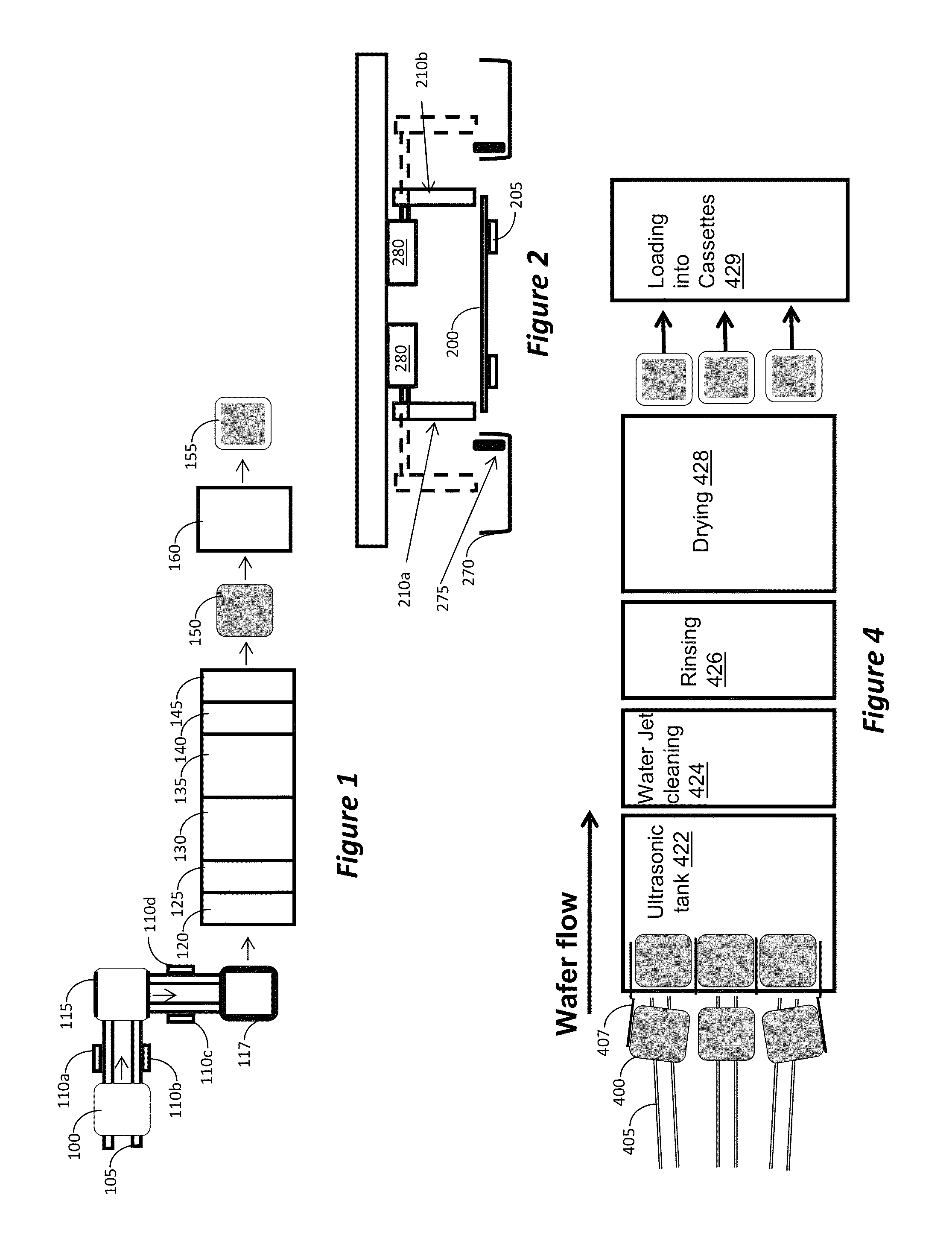Method and apparatus for masking solar cell substrates for deposition
a solar cell and substrate technology, applied in the field of semiconductor fabrication, can solve the problems of limiting the throughput of tools, unable to withstand elevated pvd or cvd process temperatures, and unable to meet the requirements of high-temperature cvd process temperatures, and achieve short cure time and high equipment throughput.
- Summary
- Abstract
- Description
- Claims
- Application Information
AI Technical Summary
Benefits of technology
Problems solved by technology
Method used
Image
Examples
example ii
[0046]According to another example, the same masking approach as disclosed above is used; however, a laser is used to burn off the organic masking material, setting the metal layer above it loose. Then, the loose deposited material can be simply blown off or washed away. In this example, the laser should have a wavelength in the range that silicon is transparent to. For example, silicon is transparent to infrared light with wavelengths above about 1.1 micrometres. Thus, by using a laser at, e.g., 1090 nanometer, the system is able to remove metal which is deposited over inkjet mask, without melting the metal nor damaging the underlying silicon. The latter was confirmed by photo luminescence analysis. The advantage of this method is that it does not reduce the cell area that collects the light, does not generate silicon particles, does not re-sputter removed metal, and does not damage the silicon that lies underneath the laser processed area. The laser may be used at power range of 3...
example iii
[0049]Another example is provided herein, which is particularly beneficial for fabrication of the back contact in silicon-based solar cells. FIGS. 8A-8E schematically illustrate a process for forming the back contact of a silicon-based solar cell, according to one embodiment. In FIG. 8A, contact 880 is formed on the backside of solar cell 800. Contact 880 may be made of, e.g., silver, using conventional technology, such as silk screening of silver paste, or inkjet printed with a conductive and solder able ink. In FIG. 8B, a mask 883 is inkjet printed over the silver contact 880, using the printing technique described in the above examples. Then the cell is transferred to a deposition system and an insulating layer 885, such as silicon oxide or silicon nitride, is deposited over the entire backside of the cell 800, as shown in FIG. 8C. The cell is then transferred to a lifting station, such as that described in Examples I or II above, and the mask 883 is removed, together with the in...
example iv
[0050]FIGS. 9A-9J illustrate an example of an embodiment for fabricating interdigitated back contact solar cell. Such a solar cell is advantageous in that it has no metal contacts on the front surface thereof, thus having larger surface for collecting sunlight. In FIG. 9A, a mask 980a is formed on the backside of the solar cell 900. The mask is inkjet printed using any of the methods described above. Then, the backside of the wafer is doped, e.g., n-type, using any conventional method, such as diffusion, ion implant, etc., thus creating doped regions 992, as shown in FIG. 9B.
[0051]In FIG. 9C mask 980a has been removed using any of the lifting methods described above, and mask 980b is inkjet to cover the areas doped in the previous step. In order to properly align mask 980b, according to one embodiment during printing of mask 980a, fiduciary elements are printed in addition to the removable mask 980a. The fiduciary elements are printed using masking fluid that is not soluble during t...
PUM
| Property | Measurement | Unit |
|---|---|---|
| wavelengths | aaaaa | aaaaa |
| power | aaaaa | aaaaa |
| areas | aaaaa | aaaaa |
Abstract
Description
Claims
Application Information
 Login to View More
Login to View More - R&D
- Intellectual Property
- Life Sciences
- Materials
- Tech Scout
- Unparalleled Data Quality
- Higher Quality Content
- 60% Fewer Hallucinations
Browse by: Latest US Patents, China's latest patents, Technical Efficacy Thesaurus, Application Domain, Technology Topic, Popular Technical Reports.
© 2025 PatSnap. All rights reserved.Legal|Privacy policy|Modern Slavery Act Transparency Statement|Sitemap|About US| Contact US: help@patsnap.com



